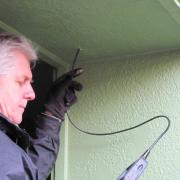Targeted or Global Repairs?: Choose the right repairs with responsible testing
Post written by David Stewart.

The building envelope (explained in detail in this earlier post) is comprised of building components (foundations, doors, windows, siding, etc) that protect a building’s interior from environmental elements (rain, snow, hail, the next-door neighbor’s “adorable” children). So, when your building envelope is damaged, you need a quick and suitable fix- especially important for the often weather-battered homes of greater Seattle and Portland.
You have options, but I am here to point out that these need careful consideration and you must have reliable testing methods to decide what’s necessary.
I’ll explain:
To fix your damaged building envelope, you can go with either
- Targeted repairs: localized repair at the damaged area. For these repairs to be successful, damage must be isolated- an isolated leak at a broken or bad miter joint in a window frame, for example.
Or
- Global repairs: rip out and replace building envelope. For these repairs to be warranted, damage must be systemic. So, if water intrusion has been noted at all tested areas in the field of the siding and can be attributed to fatally defective materials, you need global repairs.
It’s not difficult to see why it’s so important to get this right. If you go for targeted repairs, but your damage turns out to be systemic, you’ve spent money and resources without fixing the problem. Likewise, the indiscriminate replacing of building envelopes is, of course, hugely more expensive, disrupts the peaceful occupancy of the building and is an unnecessary burden to landfills.
I make sure testing methods are sound, before I advise global repairs
Usually, I come across global repair mania. Investigators often want to replace a direct fix siding with a rainscreen. They’ll test critical areas and find staining or evidence of modest and infrequent water intrusion, which, they conclude, means the entire siding requires replacement.
It doesn’t (necessarily).
To conclude that global repairs are necessary, you need a more comprehensive and statistically relevant (i.e. random) investigation. Additionally, non-destructive techniques should be used to interpolate or extrapolate known conditions observed at inspection openings made in the critical locations (i.e. finding out where we know materials to be damaged so we don’t just test those areas).
Several techniques exist for determining the moisture content of concealed framing between openings. I won’t go into them here, but, suffice to say, it is essential that a statistically relevant number of tests are performed at random locations regardless of the type of testing performed.
When in doubt, get in touch. I conduct these tests regularly and can provide a solid recommendation for repairs.
Posted: Tue, 20 Nov 2012
Read more articles about:
 Welcome to the Stewart Consulting Blog
Welcome to the Stewart Consulting Blog
Here you’ll find expert information on all things construction. If you have a specific issue you would like David to address in a blog, ask a question.

